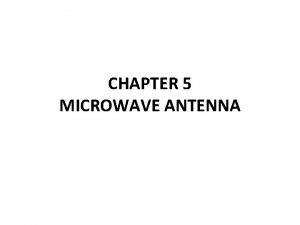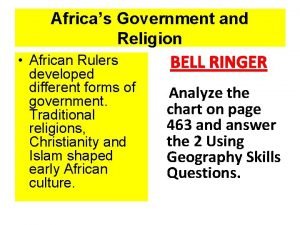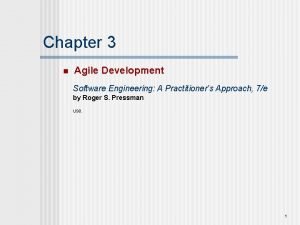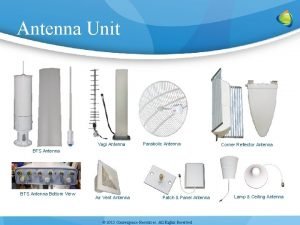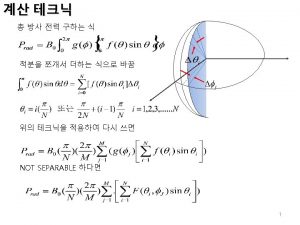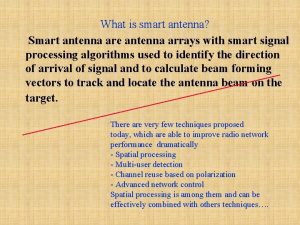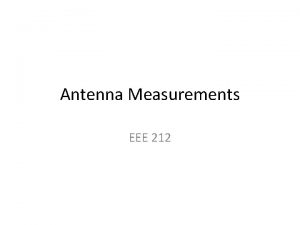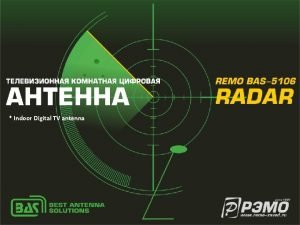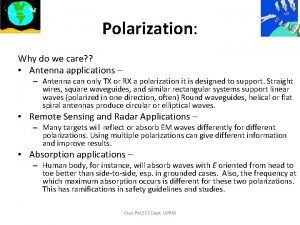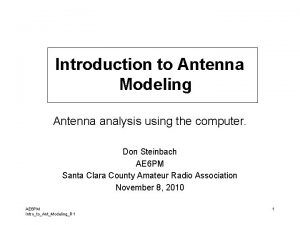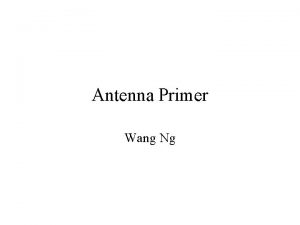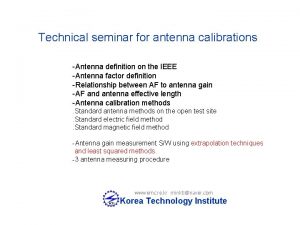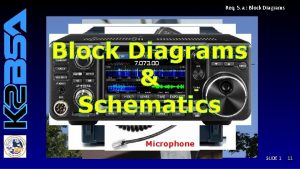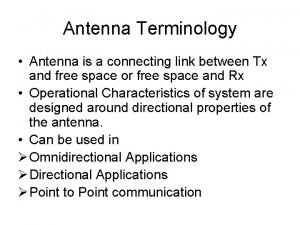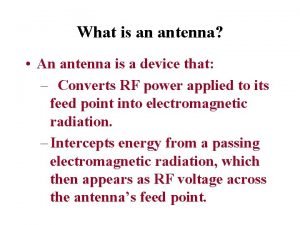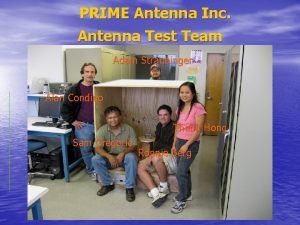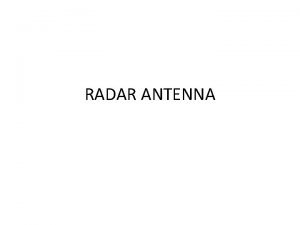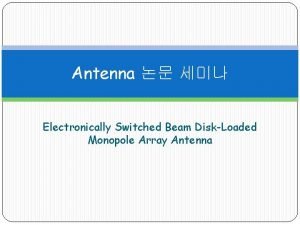Horn Antenna Horn Antenna The horn is widely





















- Slides: 21

Horn Antenna

Horn Antenna • The horn is widely used as a feed element for large radio astronomy, satellite tracking, and communication dishes found installed throughout the world. In addition to its utility as a feed for reflectors and lenses, it is a common element of phased arrays and serves as a universal standard for calibration and gain measurements of other high-gain antennas. Its widespread applicability stems from its simplicity in construction, ease of excitation, versatility, large gain, and preferred overall performance. • The horn is nothing more than a hollow pipe of different cross sections, which has been tapered (flared) to a larger opening. An electromagnetic horn can take many different forms, four of which

Horn Antenna The horn is nothing more than a hollow pipe of different cross sections, which has been tapered (flared) to a larger opening. The type, direction, and amount of taper (flare) can have a profound effect on the overall performance of the element as a radiator. An electromagnetic horn can take many different forms, four of which are (a) E-plane (c) Pyramidal (b) H-plane (d) Conical

Horn Antenna

E Plane Horn

E-Plane Horn The E-plane sectoral horn is one whose opening is flared in the direction of the E-field.

E-Plane Horn The horn can be treated as an aperture antenna. To find its radiation characteristics, the equivalent principle techniques can be utilized. To develop an exact equivalent of it, it is necessary that the tangential electric and magnetic field components over a closed surface are known. The closed that is usually selected is an infinite plane that coincides with the aperture of the horn. When the horn is not mounted on an infinite ground plane, the fields outside the aperture are not known and an exact equivalent cannot be formed. However, the usual approximation is to assume that the fields outside the aperture are zero.

Aperture Phase Distribution • It is assumed that, there exist a line source radiating cylindrical waves at the imaginary apex of the horn. As waves travel in the outward radial direction, the constant phase fronts are cylindrical which do not coincide with aperture plane. • At any point y’ at the aperture of the horn, the phase of the field will not be the same as that at the origin. • The phase difference because the wave travelled different distances from the apex to the aperture. • The difference in path of travel, designated as δ(y’), can be obtained as follows

E-Plane View

Aperture Phase Distribution Quadratic Distance Variation

Aperture Fields • When δ(y’) is multiplied by the phase constant k, the result is a quadratic phase variation between the constant phase surface and the aperture plane. It can be shown that if : (1) The fields of the feed waveguide are those of its dominant TE 10 – mode and neglecting the higher order modes. (2) The horn length is large compared to the aperture dimensions, the lowest order mode fields at the aperture of the horn considering the quadratic phase variation are given by : -

Aperture Fields

Aperture Fields • So the aperture fields become…. .

Aperture Equivalent Currents • To find the fields radiated by the horn, only the tangential components of the E - and / or H – fields over a closed surface must be known. The closed surface is chosen to coincide with an infinite plane passing through the mouth of the horn.

Aperture Equivalent Currents

Radiation Equations

Radiation Equations

Radiation Equations

Radiation Equations

Radiation Equations

Alternate solution
 Microwave antenna definition
Microwave antenna definition Rapid diffusion of popular culture
Rapid diffusion of popular culture ______ was widely-practiced in african society.
______ was widely-practiced in african society. What is biomedical therapy
What is biomedical therapy Double grooved seam joint
Double grooved seam joint Simple distillation theory
Simple distillation theory Most widely practiced religion
Most widely practiced religion The most widely used agile process, originally proposed by
The most widely used agile process, originally proposed by Des initial permutation calculator
Des initial permutation calculator Culture and the workplace
Culture and the workplace Rhadoop installation
Rhadoop installation Phối cảnh
Phối cảnh Một số thể thơ truyền thống
Một số thể thơ truyền thống Trời xanh đây là của chúng ta thể thơ
Trời xanh đây là của chúng ta thể thơ Chó sói
Chó sói Hệ hô hấp
Hệ hô hấp Tư thế ngồi viết
Tư thế ngồi viết đặc điểm cơ thể của người tối cổ
đặc điểm cơ thể của người tối cổ Các châu lục và đại dương trên thế giới
Các châu lục và đại dương trên thế giới Thế nào là hệ số cao nhất
Thế nào là hệ số cao nhất ưu thế lai là gì
ưu thế lai là gì Lp html
Lp html
